I spent a week in a city filled with roundabouts. It was delightful
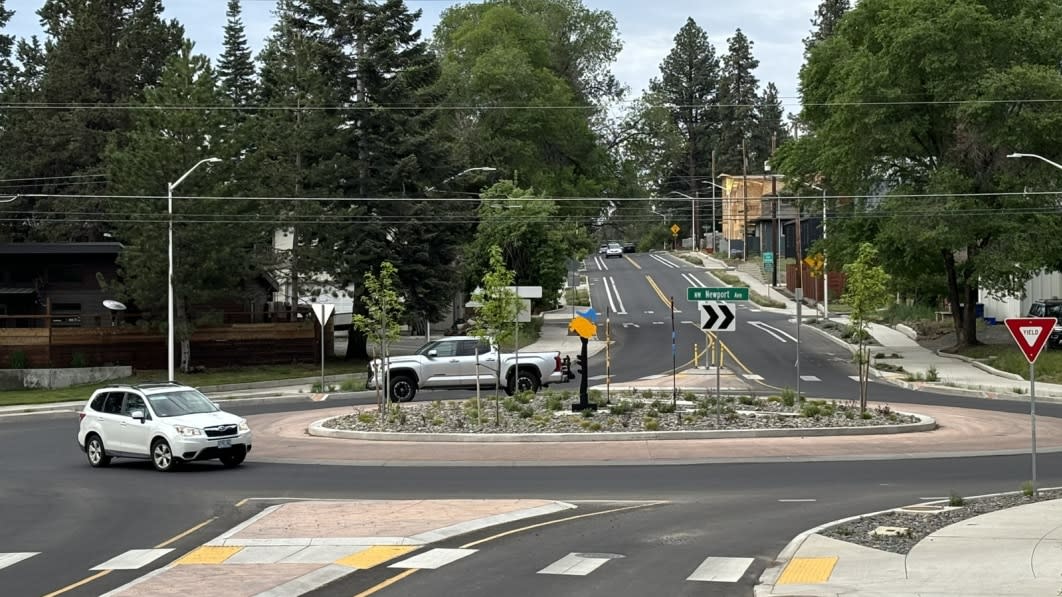
Roundabouts are usually thought of as one of those silly European things, like tiny cups of coffee and socialized medicine. It's foreign and not something for Americans. Except that there are a handful of American cities that have not only installed roundabouts, but have pretty much adopted them whole-hog, whenever possible as the default means of traffic control. They are wildly better off because of it.
The municipal king of the American roundabout is Carmel, Indiana, a suburb north of Indianapolis pronounced like the candy and not phonetically. I spent my high school years in Indianapolis and often found myself driving through Carmel. Back then, though, from 1996 to 2001, I recall Carmel as being rife with two-lane country roads and stop-sign intersections that tended to cause gridlock for the growing suburb (only 37,000 lived there back in 2000). Although the first roundabout was technically built while I lived there, it was in a private development, so I effectively experienced a Carmel with zero roundabouts. Today there are 140 of them in a city of about 102,000, which also borders one with nearly 1 million. By 2025, it will have only one stoplight.
Part of the appeal of roundabouts for Carmel was that it could keep those two-lane roads.
"We don't have to pave over paradise. We can keep our roads more narrow, and that's better for the environment," Mayor James Brainard told CBS News in 2022. He continued while taking a reporter going through a standard intersection. "A roundabout would have moved 30 cars through in the same amount of time."
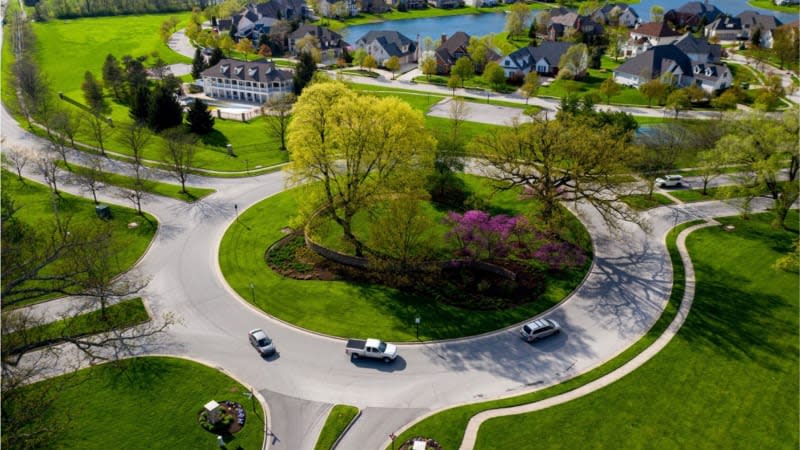
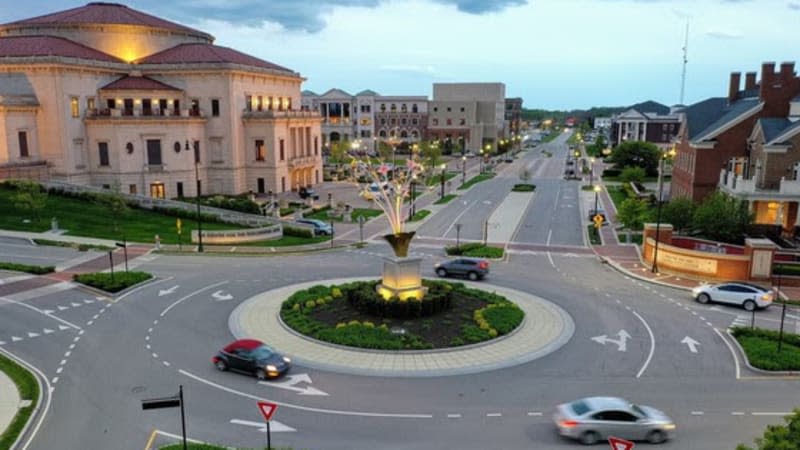
Two of Carmel's 142 roundabouts
That might be a wee bit of hyperbole, and his additional claim of roundabouts also being better for pedestrians is softened slightly by Carmel recently announcing changes to its roundabouts to include slower posted speed limits within 250 feet of roundabouts to slow cars down and give drivers more time to see pedestrians at crossing points. Nevertheless, the Insurance Institute for Highway Safety found that Carmel's roundabouts reduced the number of crashes resulting in injury by nearly half, with busy intersections such as those at highway exits by 84%. Data such as these are certainly a big reason why roundabouts are among the projects favored by the bi-partisan infrastructure law due to their safety benefits.
While I have yet to experience the roundabout majesty of modern Carmel, I did spent last week in Bend, Oregon, the roundabout capital of the Beaver State. It has roughly the same population as Carmel, but it's a stand-alone city with a historic grid as opposed to a suburb and it likely doesn't process the same volume of traffic during commuter hours. As such, only has a pittance of roundabouts compared to Carmel, but with 42, that's still a ton of roundabouts.
The first one went in roughly at the same time as Carmel got into the roundabout game, when Bend resident and real estate developer Mike Hollern pitched the city on building one at an increasingly busy intersection on the city's growing west side. His company paid for much of it. Although there was not surprisingly early NIMBY public objection, an education campaign and what was described by Bend Magazine as a "particularly successful public meeting" gave the roundabout the thumbs up. It was a success and the town has never looked back, adopting a "roundabout first" policy of traffic control.
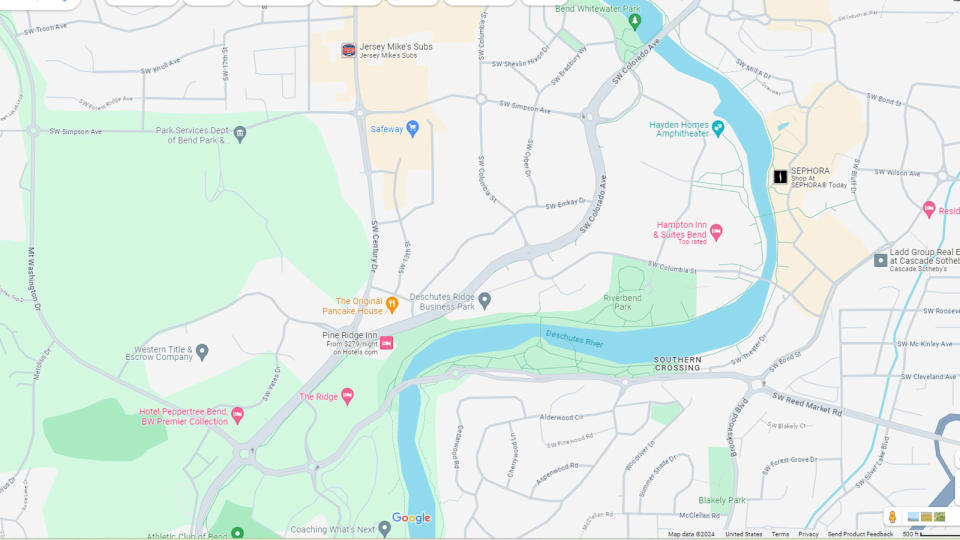
"We run every intersection through a rigorous evaluation comparing roundabouts with other intersection forms, such as stop signs or signals," City of Bend Engineer Ryan Oster told Bend Magazine. "Unless there are excessive cost or design issues, our first choice will be to recommend upgrading with a roundabout.”
Bend is a town consisting almost entirely of two-lane roads, even more so than Carmel. It can also get extremely congested during the summer when tourists flood in, and is susceptible to big-time snow fall in the winter. Both can result in nasty traffic, but it was easy to see last week how well the roundabouts cope with an influx of cars. In short, it keeps things moving, if a tad slow.
Of course, the slow part isn't necessarily a problem. In fact, it's a benefit. Bend is also a town that's perfect for cycling, be it for transport or recreation. It's also incredibly walkable and family friendly with myriad restaurants, breweries, parks and other recreation options that you don't necessarily need a car to reach. Much like Carmel, Bend has seen a reduction in crashes and a dramatic reduction in crash-related injuries, both due to the inherent design of a roundabout and speed. At one intersection, at Reed Market Road and 15th Street on the city's west side, there were 26 crash-related injuries and 65 crashes in general five years prior to the roundabout being installed; it dropped to eight and 16 in the five years thereafter.
"Consider the typical accident that could occur at a roundabout," city engineer Oster told Bend Magazine. "It happens between a vehicle already in the roundabout driving at a lower speed, sideswiping a vehicle trying to enter the roundabout. Due to the angles in the roundabout, a more severe head-on or T-collision rarely occurs. ... In a traditional intersection, it’s not unusual to see a more severe, high-speed collision.”
I negotiated several of those 42 roundabouts by car, bike and as pedestrian last week (I decided against the roller cross-country skis I spotted on a paved trail in town). Admittedly, it takes a bit more concentration on the part of pedestrians, as there's no orange hand/walking man light to tell you when to go. You have to use your own judgment. Fancy that. Of course, it helps that Oregon law requires drivers to stop for pedestrians and that Oregonians are very good about doing so at crosswalks, with those in Bend even better about it. By contrast, in the sleepy Los Angeles suburb where I live, home to only 19,000, drivers blow right on past children and mothers in baby carriages dutifully waiting to cross. That probably speaks more to people in Southern California being jerks, but that's a whole other article.
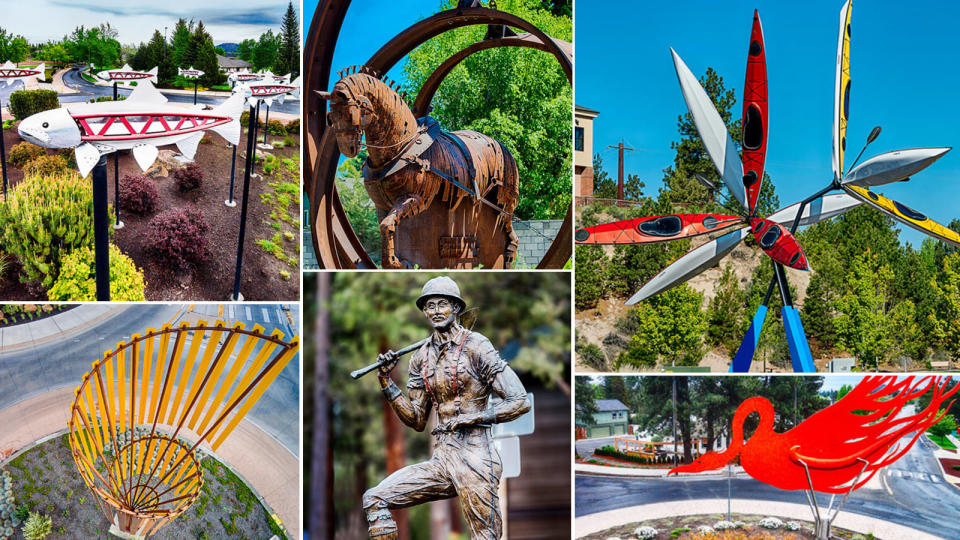
As an added bonus, Bend has taken to installing greenery and sculpture in the centers of roundabouts. Largely the result of an organization called Art in Public Places, the pieces are eclectic, though my personal favorite is the towering, multi-pronged pinwheels of kayaks inside Riverbend Park, one of several points where you can easily drop a kayak, paddleboard or inner tube into the Deschutes River. The Bend tourism board even created a self-guided tour brochure devoted to more than 20 of the roundabout sculptures.
I mean, sure beats more concrete. Ultimately, though, if there's one thing I hate in life, it's sitting around waiting. And that's exactly what you do at a traffic light. If there's another thing, it's stop-and-go traffic. And that's what you get with a stop sign. Roundabouts keep things inching along at the very least, which is a subtle difference, but a beautiful one. For traffic flow, for your insanity, and for something I haven't even touched on yet, fuel economy and vehicle emissions. The more you need to accelerate from a complete stop, the worse it is for the environment.
Of course, there's also less opportunity to roast your tires and show that Raptor in the next lane over who's boss. But if driving is your thing, and I mean you're reading Autoblog so duh, roundabouts offer more than enough dynamic joy to make up for it. When traffic is light, roundabouts provide a delightful opportunity to fling your car through a municipally sanctioned chicane and/or carousel! I mean, I'm not encouraging you to do a big, smokey drift around the roundabout at Century and Washington in Bend (I did just extol the safety virtues of the things after all), but there's just something so pleasurable about that quick flick right, flick left of going "straight" in narrow roundabouts, or doing a full 360 orbit just because you can. Having something with either a lot of suspension travel (such as the Lexus GX 550 I had last week, story on that to come) or not so much of it tends to make the experience particularly satisfying. Either way, sure beats a stop light. Just make sure to signal on your way out.
You Might Also Like



